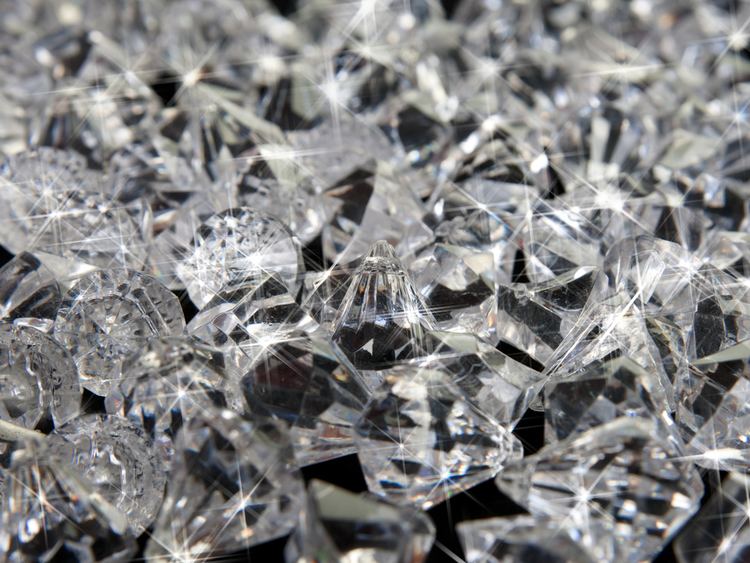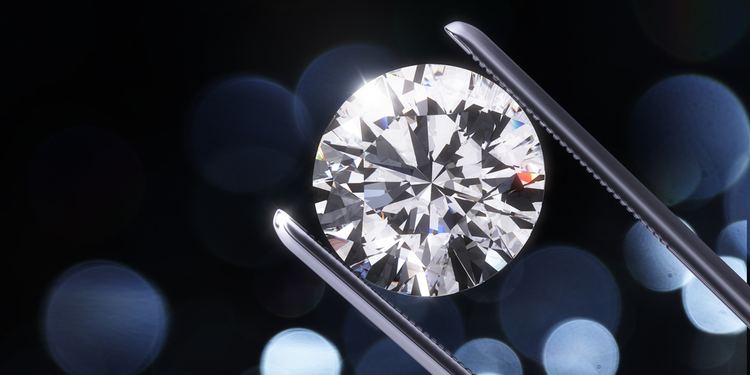 | ||
Q carbon puts diamonds in second place
Q-carbon is an allotrope of carbon, discovered in 2015, that is ferromagnetic, electrically conductive, and glows when exposed to low levels of energy. It is relatively inexpensive to make, and some news reports claim that it has replaced diamond as the world's hardest substance.
Contents
- Q carbon puts diamonds in second place
- Q carbon the material of the future
- Discovery
- Production
- Properties
- Applications
- References

According to researchers, Q-carbon exhibits a random amorphous structure that is a mix of 3-way (sp2) and 4-way (sp3) bonding, rather than the uniform sp3 bonding found in diamonds. Carbon is melted using nanosecond laser pulses, then quenched rapidly to form Q-carbon, or a mixture of Q-carbon and diamond. Q-carbon can be made to take multiple forms, from nanoneedles to large-area diamond films. Researchers are also able to create nitrogen-vacancy (NV) nanodiamonds and organize them for a variety of potential applications, ranging from nanosensing and quantum computing to biomarkers.

Q carbon the material of the future
Discovery

The discovery of Q-carbon was announced in 2015 by a research group led by Jagdish Narayan, a professor of materials science and engineering at NC State University, and graduate student Anagh Bhaumik. Coupled with the discovery of Q-boron nitride (Q-BN), and the successful conversion of carbon into diamond and h-BN into c-BN at ambient temperatures and air pressures, it was a major breakthrough in the science and technology of diamond and related materials.
The process started with Narayan's papers on laser annealing, published in Science, and culminated in 2015–16 with another series of papers and three patents: 62/245,108 (2015); 62/202,202 (2015); and 62/331.217 (2016). These patents have been licensed by Q-Carbon, LLC to commercialize products based on Q-carbon, diamond, Q-BN and c-BN.
Production

Typically, diamond is formed by heating carbon at very high temperatures (>5,000 K) and pressures (>120,000 atmospheres). However, Narayan and his group used kinetics and time control of pulsed nanosecond laser melting to overcome thermodynamic limitations and create a supercooled state that enables conversion of carbon into Q-carbon and diamond at ambient temperatures and pressures. The process uses a high-powered laser pulse, similar to that used in eye surgery, lasting approximately 200 nanoseconds. This raises the temperature of the carbon to approximately 4,000 K (3,700 °C; 6,700 °F) at atmospheric pressure. The resulting liquid is then quenched (rapidly cooled); it is this stage that is the source of the "Q" in the material's name. The degree of supercooling below the melting temperature determines the new phase of carbon, whether Q-carbon or diamond. Higher degrees of cooling result in Q-carbon, whereas diamond tends to form when the free energy of the carbon liquid equals that of diamond.

Using this technique, diamond can be doped with both n- and p-type dopants, which is critical for high-power solid-state devices. During rapid crystal growth from the melting, dopant concentrations can far exceed the thermodynamic solubility limit through a solute trapping phenomenon. This is necessary to achieve sufficiently high free carrier concentrations, since these dopants tend to be deep donors with high ionization energies.
It took researchers only 15 minutes to make one carat of Q-carbon. The initial research created Q-carbon from a thin plate of sapphire coated with amorphous (non-crystalline) carbon. Further studies have demonstrated that other substrates, such as glass or polymer, also work. This work was subsequently extended to convert h-BN into phase-pure c-BN.
Properties
Q-carbon is non-crystalline, and while it has mixed sp2 and sp3 bonding, it is mostly sp3, which leads to its unique hardness and its electrical, optical and magnetic properties. Q-carbon is harder than diamond by 10–20% because carbon is metallic in the molten state and gets closely packed, with a bond length smaller than that in diamond. Unlike all other known forms of carbon, Q-carbon is ferromagnetic, with a saturation magnetization of 20 emu/g and an estimated Curie temperature of approximately 500 K.
Depending on the quenching rate from the supercooled state, Q-carbon can be a semiconductor or metallic. It glows more than diamond when exposed even to low levels of energetic radiation because of its stronger negative electron affinity.
Applications
Since the discovery of Q-carbon is relatively recent, practical applications are in their infancy. Potential technologies include high-powered electronic and photonic devices, high-speed machining, deep sea drilling and biomedical sensing. Q-carbon's low work function and negative electron affinity make it an attractive alternative for efficient field emission displays. The ability to achieve controlled introduction of nitrogen-vacancy centers in a variety of nanostructures also opens the possibility of novel quantum nanotechnologies in the physical and biological sciences: for example, single photon sensors, nanoscale electronic and magnetic sensing, single-spin magnetic resonance and fluorescent biomarkers.
